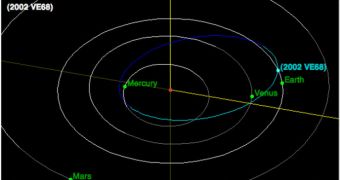The international astronomical community is currently trying to assess whether a space body called 2002 VE68 can indeed be classified as a Venusian moon. The second planet from the Sun never had a satellite before, so experts want to be sure that they get the calculations right.
The case of Earth is pretty clear-cut, as the Moon can be observed at all times from locations around the world. It is located so close that you can see features on its surface with the naked eye.
But on Mars things are a bit fuzzier. Phobos and Deimo, its two moons, are most likely captured asteroids or clumps of debris generated by space collisions, but cannot be readily seen from the surface of the planet.
On Venus, things are even less clear. The proposed moon 2002 VE68 may earn this status simply because it is in a 1:1 resonance with our neighboring planet.
Expert Michael Hicks recently led a team of astronomers at the NASA Jet Propulsion Laboratory (JPL) in a study to analyze the spin period and composition of the body.
The object was discovered on November 11, 2002, using the Lowell Observatory Near Earth Object Search (LONEOS). Researchers determined at the time that the near-Earth object (NEO) first had a rather uncommon trajectory through space.
Subsequent studies have demonstrated that its orbit around the Sun changed some 7,000 years ago, when it moved so close to the Earth that our planet's orbit caused a shift in the space rock's orbit.
As a result, 2002 VE68 started to wander inside the orbit of Mercury at its closest to the Sun, and reach the orbit of Earth at its farthest. This placed it in a 1:1 orbital resonance with Venus.
Basically, what this means is that they take the same amount of time to complete a full revolution around Sun. Neptune and Pluto are in a 3:2 orbital resonance – for each 3 Neptunian orbits, Pluto completes 2, Universe Today reports.
Established astronomical definitions say that the object is a quasi-satellite of Venus. But one of the most interesting things about such clear-cut orbital resonances is that they are unstable.
Generally, bodies caught within such a system tend to shift their orbits or exchange momentum until the resonance is gone. Equations developed by the JPL team show that the Venus-2002 VE68 system will only remain in resonance for the next 500 years or so.
The new study determined that the Venusian quasi-satellite is about 200 meters in diameter, and that it spins around its central axis once every 13.5 hours.
Interestingly, the JPL group determined that the object may in fact be a contact binary, a type of structure that features two large space rocks orbiting a common center of gravity, while in contact with each other.
When viewed from the outside, the shape of such a structure resembles an hourglass of sorts.

 14 DAY TRIAL //
14 DAY TRIAL //